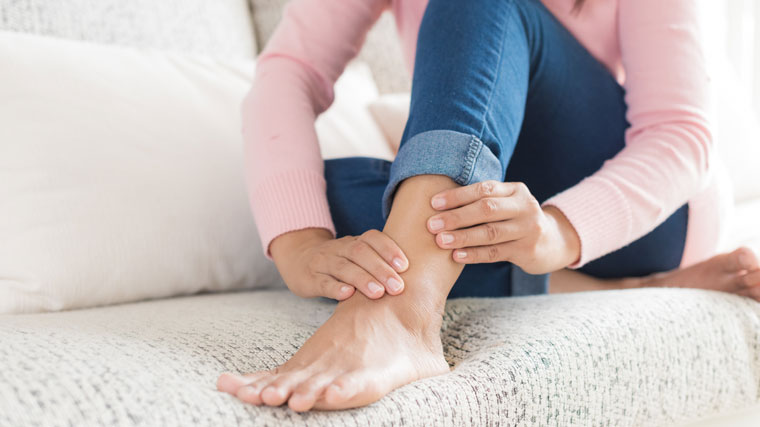Care For Your Foot And Ankle Joints – Your Foundation

Answer a few questions and we'll provide you with a list of primary care providers that best fit your needs.
Your feet and ankles serve as your body’s foundation. And when the joints of this foundation become injured or arthritic from wear and tear (and supporting the rest of your body), other joints in your feet or ankles – and farther up, like your knees, hips, and spine – can take on more stress.
If one of your foot or ankle joints becomes arthritic and painful, you’ll likely change the way you walk and feel. These changes can adversely impact other joints.
The sooner you call your health care provider to address the pain of osteoarthritis in a foot or ankle joint the better. It may be severe or more severe than you think it is. And it could be causing other damage to other joints in the foot or ankle.
As one joint becomes more stiff, the other joints have to take up the load for that joint, and so it can be causing other problems in other areas of the foot or ankle. Other things such as bone spurs can cause impingement, and sometimes these are easier treated than waiting until the joints have been completely destroyed by the arthritis.
Common Locations Of Foot And Ankle Arthritis
The ankle joint is a relatively common place for arthritis. And the big toe joint is one of the more common places in the foot for arthritis. The big toe joint is where gout (a type of arthritis) seems to attack people the most, so that's one big factor in developing arthritis.
Bunions (an enlargement of bone or tissue) also occur in the big toe joint, causing an abnormal loading inside the joint, which can lead to arthritis.
Arthritis can also develop in the hindfoot, just below the ankle. This can happen if you have a severe flat foot or high arches. A flatfoot or high arches can also lead to arthritis in the midfoot.
Symptoms Of Foot And Ankle Arthritis
Foot and ankle arthritis can develop slowly. You may not notice much at first, except some pain every now and then. It can come and go. It can hurt all the time or for brief bursts of hours to days. It's usually associated with activity level, so the higher the activity level, the more an arthritic joint will hurt you.
When the arthritis becomes more severe, swelling develops around the joint. Swelling can develop around the big toe, the midfoot, the hindfoot, or the ankle.
Diagnosis Of Foot And Ankle Arthritis
The best way to diagnose foot and ankle arthritis is through an X-ray. Cartilage doesn’t show up well on X-rays. But when cartilage wears away between bones of a joint – a key sign of arthritis – the space between the bones becomes smaller, which an X-ray can point out.
To better assess the space between bones in foot or ankle joints, weight-bearing X-rays are often taken. This gives a good indication of how advanced the arthritic process has become.
Treatment Of Foot And Ankle Arthritis
Conservative Treatment Options
If you are found to have arthritis in a foot or ankle, your doctor will first consider conservative management options before considering surgery. Based on your situation, your doctor may recommend conservative measures such as:
- Pain medications. These include over-the-counter nonsteroidal anti-inflammatories (NSAIDs), such as ibuprofen and naproxen.
- Temporary stabilization. One of the most common conservative practices is placing the foot in a boot. This helps stabilize the arthritic foot to provide temporary relief and to take pressure off the joints.
- Orthotic management. The cause of many arthritic cases in the foot can be traced back to malalignment of joints, such as flat foot or a high arch. A specialist can make orthotics, custom-made inserts for shoes to help correct these problems and provide comfort.
- Injections. The next step of treatment may include the use of cortisone injections into the joint that is causing the problem. These injections help minimize inflammation in the joint from six weeks to six months. Minimizing inflammation usually helps reduce pain in the joint. Your provider could also recommend an injection of platelet-rich plasma to relieve pain and help repair the joint.
- Physical therapy. Some arthritis cases benefit from physical therapy, which is aimed at strengthening muscles in the body that help support the joint that is causing pain, as well as stretching out muscles that may be too tight.
Stretching is a simple way you can help protect your feet and ankles from arthritis. One of the most common problems in the foot and ankle is a tight Achilles tendon. And a tight Achilles tendon can lead to problems with the foot such as arthritis, especially in someone who's flatfooted. This will cause extra strain through the midfoot, and can, actually, lead to further damage in the midfoot from not having as much movement through your ankle. When you roll over on your foot, you'll tend to put more stress through these joints, which can lead to premature arthritis.
Surgical Treatment Options
When conservative treatment measures don’t relieve symptoms, or lose their effectiveness as arthritis progresses, it may be time to consider surgical options. These options include:
For the Ankle
- Removal of bone spurs. This relatively minor procedure, for mild arthritic conditions, removes bone spurs – bony growths that form on normal bone and cause wear and tear on other bone and soft tissue in the ankle.
- Ankle fusion or ankle arthrodesis. For severe ankle arthritis, this procedure is sometimes considered “the gold standard” for pain relief. It involves
removing remaining cartilage from the joint and joining with screws the shinbone (tibia) to the talus bone, the first bone in the foot. Your body will naturally bridge the two fused bones with more bone as they heal.
This eliminates the painful friction of the two bones rubbing against each other.
For the Foot
- Fusion of the big toe joint. Like ankle fusion, this eliminates bones rubbing against each other.
- Cartiva implant. Cartiva is an artificial material that replaces and acts like natural cartilage, to cushion the big toe joint. This procedure has become a mainstay for those seeking an option to keep their joint moving, as opposed to doing a fusion. It alleviates pain and allows you to flex your big toe.
- Midfoot fusion. The joints that make up the arch in the middle of your foot aren’t meant to move much. But if they do start to move, it hurts. One of the best options is to fuse those joints together. During recovery, the bone heals together, much like a fracture does. The procedure results in no loss of motion.
- Hindfoot surgery. Arthritis in the hindfoot often involves misalignment related to a flatfoot or a high arch foot abnormality. X-rays help check the foot alignment. If they show mild arthritis or no arthritis, a procedure is performed to realign the foot. This relieves the joints of abnormal, painful stress, preserving your ability to move the foot from side to side. However, if significant arthritis is found, a fusion procedure is often the best option.
Answer a few questions and we'll provide you with a list of primary care providers that best fit your needs.
Source: American Orthopaedic Foot and Ankle Society; American Academy of Orthopaedic Surgeons; American Podiatric Medical Association




